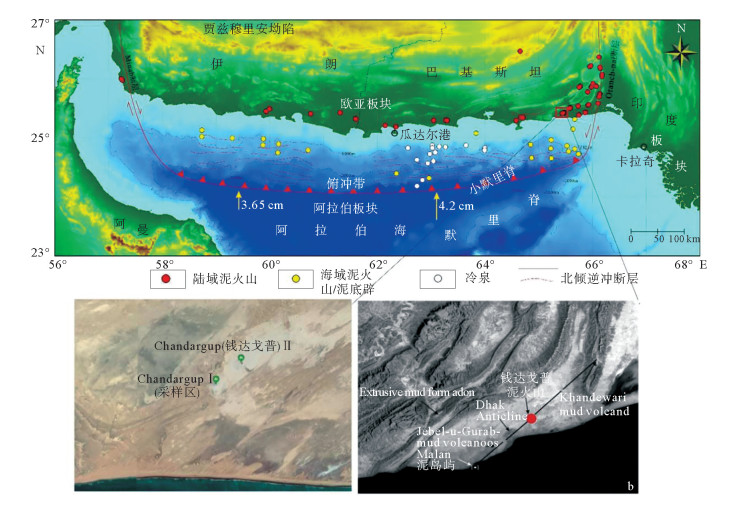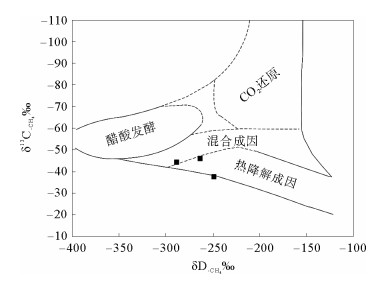DIFFERENCE IN GAS SOURCES FOR OFFSHORE AND ONSHORE MUD VOLCANOES IN MAKRAN ACCRETIONARY WEDGE
-
摘要:
为了探讨马克兰增生楔海陆泥火山气源成因及其差异,对取自陆上钱达戈普(Chandargup)泥火山口的5个水样进行了气体组分及其碳、氢同位素测试。结果显示,陆上泥火山中的气体组分主要为CH4和CO2,其CH4碳同位素平均值为-42‰,属热解成因气。对比分析马克兰增生楔海陆沉积地层、断裂分布、地温梯度、有机质含量等资料,认为海域与泥火山有关的生物成因气主要来自于浅表层的Hinglaj-Ormara组泥岩,而陆域热解成因气主要来自深部的Hoshab组页岩或者更深处泥页岩,推测马克兰增生楔陆域深部地层有一定的油气资源潜力。
Abstract:In order to investigate the origin of mud volcanic gas source in Chandargup area of the Makran accretionary wedge and the differences between onshore and offshore mud volcanic gas sources, the gas composition and carbon and hydrogen isotopes of five water samples from onshore mud volcanic crater were tested. The results show that the gas components in the onshore mud volcano are mainly composed of methane and carbon dioxide, and the average carbon isotope of methane is -42‰, indicating an origin of thermogenic gas. By collecting the data of sedimentary strata, fault distribution, geothermal gradient and organic matter content onshore and offshore of the Makran accretionary wedge, it is concluded that the biogenic gas related to offshore mud volcanoes mainly comes from shallow Hinglaj-Ormara mudstone, while the onshore thermogenic gas mainly from deep Hoshab shale or deeper mudstone and shale, indicating that there is a potential for oil and gas resources in the deep strata of the onshore Makran accretionary wedge.
-

-
表 1 泥火山水样中气体组分及C、H同位素测试结果
Table 1. Gas content and C and H isotopes from water samples of mud volcano
样品编号 CH4/% CO2/% CH4 /%
相对含量CO2/%
相对含量δ13C-CH4/‰ δD-CH4/‰ δ13C-CO2/‰ 1-1 * * * * * * -0.17 1-2 0.06 0.30 17 83 * * -4.78 1-3 0.57 0.29 66 34 -44.12 -289 -1.48 1-4 0.20 0.23 47 53 -37.44 -249 -0.62 1-5 0.12 0.34 26 74 -45.95 -264 -1.89 表 2 增生楔海域和陆域地层、岩性、地温梯度、TOC含量等分布
Table 2. The stratigraphic distribution of strata, lithology, geothermal gradient and TOC content in the onshore and offshore Makran accretionary wedge
年代 海域地层 岩性 地层厚度/km 地温梯度/℃ TOC/% 中新世以来层序Ⅰ和Ⅱ Hinglaj-Ormara组 泥岩 >2 25 >1(OMZ) Parkini组 粉砂质沉积 渐新世-中中新世层序Ⅲ Panjgur组 上部砂、下部
泥质沉积Hoshab组 年代 陆域地层 岩性 地层厚度/km 地温梯度/℃ TOC/% 上新世-更新世 Chitti/Ormara组 细粉砂岩 2-3 25 上新世 Talar/Hinglaj组 浅灰色泥岩 晚中新世 Parkini组 泥岩 1 0.64 Panjgur组 砂岩 >2 渐新世-中中新世 Hoshab组 页岩 0.54 -
[1] Milkov A V. Worldwide distribution of submarine mud volcanoes and associated gas hydrates[J]. Marine Geology, 2000, 167(1):29-42. http://d.old.wanfangdata.com.cn/NSTLQK/10.1016-S0025-3227(00)00022-0/
[2] Kopf A J. Significance of mud volcanism [J]. Reviews of Geophysics, 2002, 40(2):1-52. http://www.wanfangdata.com.cn/details/detail.do?_type=perio&id=10.1029/2000RG000093
[3] 刘嘉麒.大地"沸腾"——泥火山[J].大自然探索, 2003, (8):8-9. http://www.cnki.com.cn/Article/CJFDTotal-DZRT200308002.htm
[4] 黄华谷, 邸鹏飞, 陈多福.泥火山的全球分布和研究进展[J].矿物岩石地球化学通报, 2011, 30(2):189-197. doi: 10.3969/j.issn.1007-2802.2011.02.010
[5] 何家雄, 翁荣南, 祝有海, 等.台湾南部泥火山及伴生气地质地球化学特征及其油气地质意义[J].天然气地球科学, 2012, 23(2): 319-326. http://d.old.wanfangdata.com.cn/Conference/7863435
[6] Sun C H, Chang S C, Kuo C L, et al. Origins of Taiwan's mud volcanoes: Evidence from geochemistry. Journal of Asian Earth Sciences, 2010, 37(2): 105-116. doi: 10.1016/j.jseaes.2009.02.007
[7] Dimitrov L I. Mud volcanoes-The most important pathway for degassing deeply buried sediments [J]. Earth-Science Reviews, 2002, 59(1-4):49-76. doi: 10.1016/S0012-8252(02)00069-7
[8] Etiope G, Milkov A V. A new estimate of global methane flux from onshore and shallow submarine mud volcanoes to the atmosphere [J]. Environmental Geology, 2004, 46(8):997-1002. doi: 10.1007/s00254-004-1085-1
[9] Etiope G, Feyzullayev A, Baciu C L. Terrestrial methane seeps and mud volcanoes: A global perspective of gas origin [J]. Marine and Petroleum Geology, 2009, 26(3):333-344. doi: 10.1016/j.marpetgeo.2008.03.001
[10] Shindell D T, Faluvegi G, Koch D M, et al. Improved Attribution of Climate Forcing to Emissions [J]. Science, 2009, 326(5953):716-718. doi: 10.1126/science.1174760
[11] Demets C, Gordon R G, Argus D F. Geologically current plate motions [J]. Geophysical Journal International, 2011, 187(1): 1-80. doi: 10.1111/j.1365-246X.2011.05140.x
[12] Smith G L. The structure, fluid distribution and earthquake potential of the Makran Subduction Zone, Pakistan [D].Southampton: University of Southampton, 2013.
[13] 龚建明, 廖晶, 张莉, 等.印度洋北部马克兰增生楔泥火山分布及主控因素探讨[J].现代地质, 2018, 32(5): 1025-1030. http://d.old.wanfangdata.com.cn/Periodical/xddz201805015
[14] 廖晶, 龚建明, 何拥军, 等.马克兰增生楔地层层序及发育过程[J].海洋地质前沿, 2019, 35(4): 69-72. http://hydt.cbpt.cnki.net/WKA/WebPublication/paperDigest.aspx?paperID=e2d7e50d-5455-4540-86ac-b98f0a4b32fc
[15] Delisle G, Rad U V, Andruleit H, et al. Active mud volcanoes on and offshore eastern Makran, Pakistan [J]. International Journal of Earth Sciences, 2002, 91(1):93-110. doi: 10.1007/s005310100203
[16] Delisle G. The mud volcanoes of Pakistan [J]. Environmental Geology, 2004, 46(8):1024-1029. doi: 10.1007/s00254-004-1089-x
[17] 赵祖斌, 杨木壮, 沙志彬.天然气水合物气体成因及其来源[J].海洋地质前沿, 2001, 17(7):38-41. http://hydt.cbpt.cnki.net/WKA/WebPublication/paperDigest.aspx?paperID=10E71387-E0CB-41C4-8971-C9516CA7D99A
[18] Abbasi I A, Kakar D M, Khan M A, et al. Mud volcanoes in an active fore-arc setting: a case study from the makran coastal belt, SW Pakistan[M]//Tsunamis and Earthquakes in Coastal Environments. 2016.
[19] Schlüter H U, Prexl A, Gaedicke C, et al. The Makran accretionary wedge: sediment thicknesses and ages and the origin of mud volcanoes [J]. Marine Geology, 2002, 185(3):219-232. https://www.sciencedirect.com/science/article/abs/pii/S0025322702001925
[20] Rad U V, Schulz H, Khan A A, et al. Sampling the oxygen minimum zone off Pakistan: glacial-interglacial variations of anoxia and productivity (preliminary results, sonne 90 cruise)[J]. 1995, 125(1/2): 7-19.
[21] Rad U V, Berner U, Delisle G, et al. Gas and fluid venting at the Makran accretionary wedge off Pakistan[J]. Geo-Marine Letters, 2000, 20(1):10-19. doi: 10.1007/s003670000033
[22] Smith G L, Mcneill L C, Henstock T J, et al. Fluid generation and distribution in the highest sediment input accretionary margin, the Makran [J]. Earth and Planetary Science Letters, 2014, 403:131-143. doi: 10.1016/j.epsl.2014.06.030
[23] Smith G L, Mcneill L C, Wang K, et al. Thermal structure and megathrust seismogenic potential of the Makran subduction zone [J]. Geophysical Research Letters, 2013, 40(8):1528-1533. doi: 10.1002/grl.50374
[24] Harms J C, Chapel H N, Francis D C. The Makran coast of Pakistan: its stratigraphy andhydrocarbon potential[C]//Haq B U, Milliman J D. Marine geology and oceanography of Arabian Sea and Coastal Pakistan. Van Nostr and Reinhold, New York, 1984: 3-26.
[25] Kazmi A H, Abbasi I A. Stratigraphy and historical geology of Pakistan [R]. Department and NCE in Geology, University of Peshawar, Pakistan, 2008: 551.
[26] Etiope G, Feyzullayev A, Milkov A V, et al. Evidence of subsurface anaerobic biodegradation of hydrocarbons and potential secondary methanogenesis in terrestrial mud volcanoes[J]. Marine and Petroleum Geology, 2009, 26(9):1692-1703. doi: 10.1016/j.marpetgeo.2008.12.002
[27] Khan M A, Raza H A, Alam S. Petroleum geology of the Markran region: implications for hydrocarbon occurrence in cool basins [J]. Journal of Petroleum Geology, 2010, 14(1):5-18. https://onlinelibrary.wiley.com/doi/abs/10.1111/j.1747-5457.1991.tb00295.x#references-section
-




 下载:
下载:
